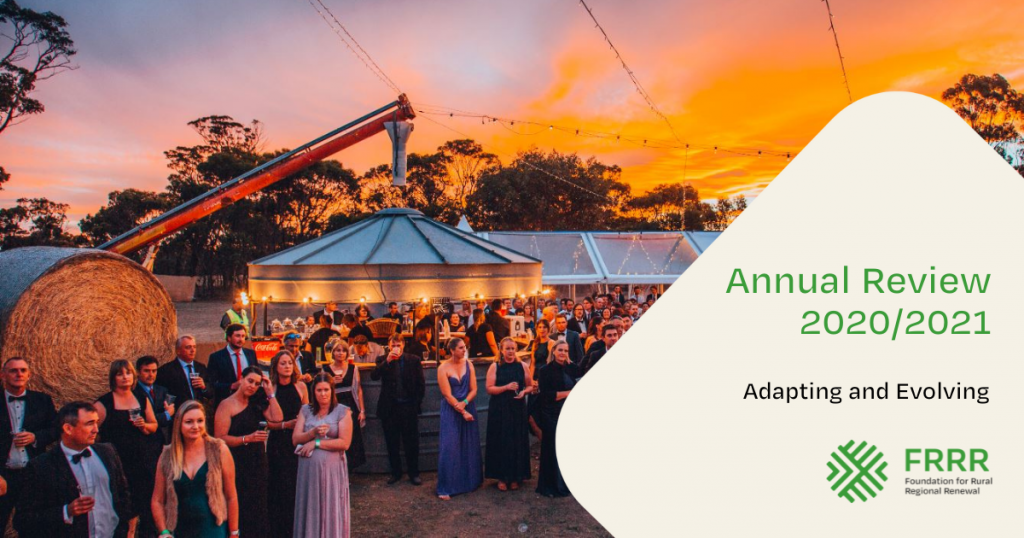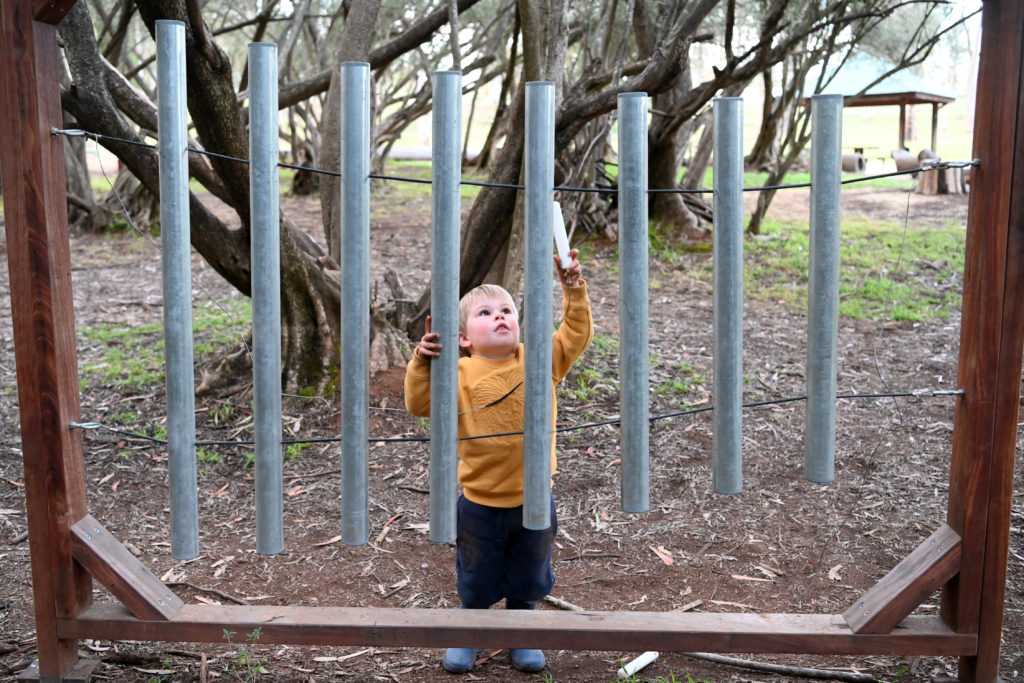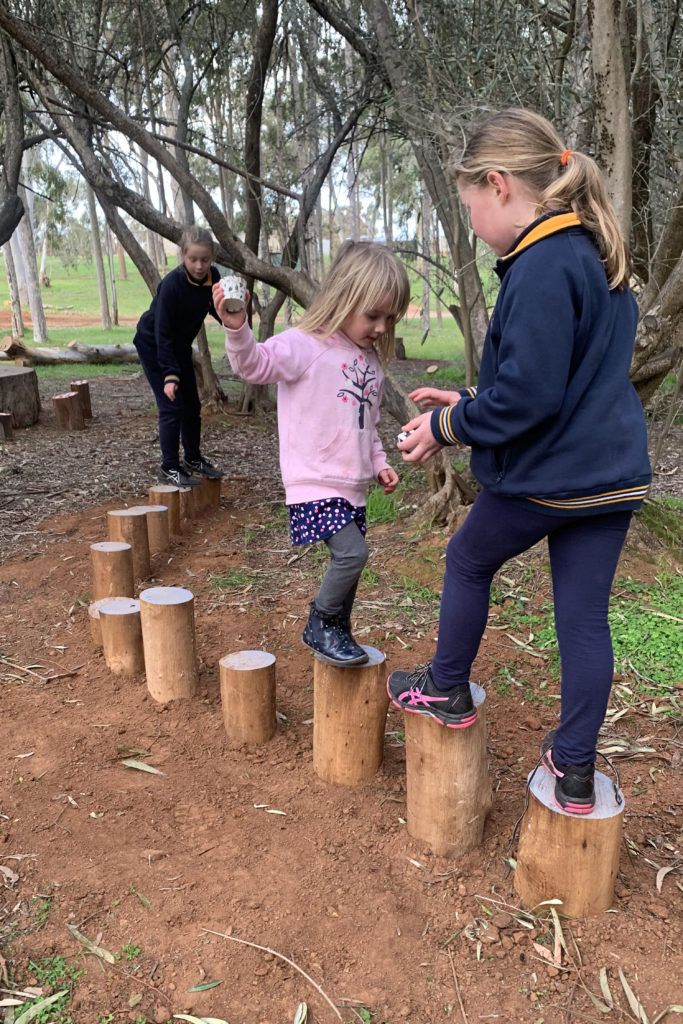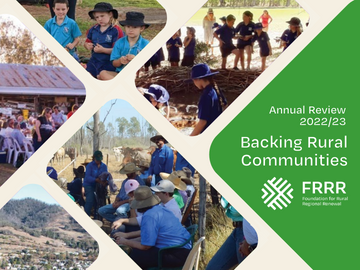Foundation for Rural & Regional Renewal (FRRR)
Unmet need also increases
FRRR distributed a record $22.5 million last financial year, shared across more than 550 remote, rural and regional communities across Australia, according to the Foundation’s just-released 2022/23 Annual Review.
Remote and rural communities experience inequity, disadvantage and vulnerability across many basic aspects of day-to-day life. Yet they continue to rise to the challenge, innovate and deliver solutions that not only address issues but prove that better outcomes are possible with just a bit of support.
Last financial year, FRRR’s 1,158 grants enabled 972 grassroots organisations and groups to pursue local projects that responded to the now all-too familiar effects of natural disasters; accelerated the net-zero transition; and addressed long-standing structural issues such as housing, energy and food security, service provision and digital inclusion.
Natalie Egleton, CEO of FRRR, said the Foundation saw the largest number of applications in its 23-year history.
“In the face of these challenges, communities continue to pull together, harnessing the strengths of local people and their connection and commitment to their places to forge ahead. I’m proud of the role that FRRR has played in supporting these remote, rural and regional communities to strengthen, adapt and innovate to navigate and find solutions to these challenges.
“Last financial year, FRRR received 2,639 eligible grant applications requesting a total of $64 million, up more than 25% on the prior year. What this signals is that life is getting back to ‘normal’ following COVID, but it also highlights the ongoing challenges remote, rural and regional communities are facing when it comes to securing funding for local projects.
“Unsurprisingly, more than a third of our grants went to communities vulnerable to, or impacted by, climate-related disasters. Nearly 430 grants totalling $11.1 million were awarded for initiatives supporting the medium to long-term recovery of places affected by disasters, and projects helping to prepare communities for future climate-related impacts.
“In 2023 we received more than 1,310 donations, ranging from $1 to $7.9 million, totalling just over $25.4 million (excluding fees and deferred income). We are grateful for the continued commitment of our supporters and the trust they place in us to get funding to where it’s needed most and to strengthen capacity to adjust and rise to the challenges in these communities.
“Despite an increase in donations, FRRR could still only fund just over half of the eligible applications received. So, we continue to seek new partnerships with government, philanthropy, business and individuals to allow us to fund more of these projects.
“No matter how big or small, we know our grants make a difference to these communities. This year, for every dollar granted, a further $1.76 was leveraged, opening the door to further funding opportunities, and building confidence.
“We also continued to advocate for more well-informed investment in rural people and organisations. Looking ahead, we’ll keep having these conversations, sharing our insights to ensure these people and places get improved access to sustainable social and physical infrastructure and opportunities that build community connections.
“The tenacity of remote, rural and regional people to keep their communities vibrant and sustainable motivates us to continue to strive for our shared vision for a more vibrant, resilient and sustainable remote, rural and regional Australia,” Ms Egleton concluded.
FRRR’s FY23 Annual Review is available at www.frrr.org.au/AR23.
Spirit of charity shines bright in a tough year to help rural communities adapt and evolve
A unique Australian charity significantly increased its year-on-year grantmaking, giving remote, rural and regional communities across the country a much-needed funding boost as they adapted to the impacts of natural disasters and COVID-19.

FRRR (the Foundation for Rural & Regional Renewal) supports small not-for-profit organisations across rural Australia through a mix of grant funding and capacity building activities. Their aim is to ensure local grassroots groups have the tools and support they need to implement projects that strengthen and sustain the vitality of their communities, and their organisations.
Last financial year, FRRR awarded nearly $20 million through 917 grants, an increase of around a third on the prior year. A significant portion ($4.1 million) went toward 203 recovery projects in communities impacted by the Black Summer bushfires, who were also grappling with economic and social fallout of COVID-19.
For the last 20 years, FRRR has created collaborative partnerships with Government, philanthropy, business and private funders to provide support to local organisations to fill the gaps, and address inequities in services in these areas and, critically, to strengthen community resilience.
Despite it being a tough year, everyday Australians and the philanthropic sector in particular continued to give, enabling FRRR to reach some of the smallest and most remote communities.
FRRR CEO Natalie Egleton said that while many grants to community groups are project-based, last year, in response to community needs, the organisation adapted its approach to also support more operational costs.
“The places we support are really small communities – sometimes just tens or hundreds of people – and so very few volunteers carry a lot of the load. Between the impacts of bushfires, drought, floods and COVID-19 restrictions, traditional fundraising was simply not possible. We were able to step in and support projects in more than 540 different postcodes across the country.
“With these communities being so resourceful, most projects don’t actually need all that much funding. In fact, our median grant was only around $13,000. While that figure has increased over time, we still award many grants that are just a few thousand dollars.
“It’s surprising just how big an impact can be created with relatively little, especially when people come together and given collaboratively, as they have this year,” Ms Egleton said.
“While it’s been a tough 12 months, thanks to the support of our corporate and philanthropic partners, and hundreds of individual donors, we are proud to have been able to sustain and indeed strengthen many rural communitites,” Ms Egleton concluded.
FRRR’s FY2020/21 Annual Review is available at www.frrr.org.au/AR21.
Nestled in the heart of the Bundaleer Forest lies a quiet haven where local South Australian families can visit to reconnect with nature, and each other. Just eight kilometres from Jamestown, the picnic area of the Bundaleer Forest and the idyllic Maple Walk have been a local favourite for years. And yet, something was missing.
Until 2018, families would have to drive more than 200km to visit the nearest nature play park. These types of parks provide an opportunity for children to ignite their imagination, and enjoy learning and developing key skills while being surrounded by nature.
After the devastating bushfires that tore through the Bundaleer Forest in 2013, it became clear that the community needed a new tourist destination to drive business into the area.
After three years of work by the Northern Forests Community Initiatives Group, The Bundaleer Forest Community Areas Association (BFCAA) was formed. Their mission is to protect, preserve, promote and enhance the recreational, environmental, cultural, historical and educational values of the community areas of the Bundaleer Forest – and delivering the nature play area was just one of their initiatives.
The local community applied for the FRRR Small Grants for Rural Communities program, which provided $5,000 in funding for the nature play area, thanks to support from The Yulgilbar Foundation. Over 12 months, the community banded together to design and build the new park, with enormous input from the BFCAA volunteers, and Lion Club volunteers.

The finished nature play area is full of things to do, with a basket swing, picnic table & story time area, goblin & fairy house, mud kitchen, stepping logs, giant xylophone, swinging bars, tight rope and climbing rope. The facility has encouraged local schools, kindergartens and other groups to visit locally, and enjoy the benefits of having such a fun and engaging play area right on their doorstep.

Each of the nature play structures has a specific goal for promoting the development of strength, creativity, and providing a sensory experience. Children can experience being in nature and enjoying the fresh air, while developing their balance, body awareness, concentration and gross motor skills.
“Anyone who sits quietly and observes children playing in the Bundaleer nature play space will fully understand the impact of this project. While it is impossible to measure, there is a phenomenal impact on many levels of children development through nature play. It’s where children’s imaginations can come to life, and world where fairies and dragons are more real than make believe. It’s where children cooperate to make music together on the giant instrument, and learn to take turns on the swing and hold the hand of a younger chid as they learn to balance on the stepping logs.”
Mel Kitschke
Bundaleer Forest Community Areas Association


